The Voyager Missions¶
New Age of Exploration¶
In the 1960s, NASA scientist and engineers began sending robotic probes to explore our planetary neighbors. This greatly expanded our knowledge of theses worlds and gave us entirely new, close-up views of the inner planets that we could only before dream of. This began a new age of exploration, bringing into our reach those distant mysterious discs.
Researchers and engineers became fascinated by the new possibilities afforded to them, and looked deeper into what was now possible. Better rockets and spacecraft were built, and we went from predicting and characterizing orbits to designing and plotting our own.
A Grand Tour¶
By the 1970s our sights were set on the outer planets. With our new found study of orbital mechanics a special opportunity presented itself; the outer planets were soon to be positioned in a way that allowed two spacecraft to efficiently travel and visit all of the outer planets, including Pluto which was then still classified as a planet.
NASA began drawing up plans for a Grand Tour of the outer solar system. One probe would be sent to Jupiter, Saturn, and Pluto, with another to Jupiter, Saturn, Uranus, and Neptune. Both would utilize the gravity assist maneuver to increase their speed and propel them to reach their next target.
The Gravity Assist Maneuver¶
The gravity assist maneuver can be a difficult aspect of orbital mechanics to intuitively understand. But as we say in the field of rocket science, “it ain’t music theory”. To understand this maneuver, let’s imagine a spacecraft fly by in a planetocentric (planet centered) reference frame, then in a heliocentric (Sun centered) reference frame.
Planetocentric¶
The trajectory of the spacecraft in the planetocentric reference is a hyperbolic orbit. Unlike the usual elliptical orbit, our spacecraft is traveling faster than escape velocity. It will come towards the planet following a path that can be modeled by a hyperbola, coming towards the planet before going part way around before continuing, leaving the planet behind.
Like an elliptical orbit, as the spacecraft comes closer to the planet, the speed of the spacecraft increases, then decreases as the spacecraft travels away. At the same distance coming in and leaving, the speed of the spacecraft is the same. So then how is the speed of the spacecraft once it leaves faster then when it approached the planet?
Heliocentric¶
In the heliocentric reference we see that as the spacecraft approaches the planet, the planet is also moving. The planet will pull the spacecraft around the planet as it flies by. If the spacecraft comes from behind the planet, relative to the planet’s motion, for the spacecraft to have the same planetocentric speed leaving the planet, the spacecraft’s heliocentric speed must increase by the speed that the planet is orbiting. This increase of speed isn’t free though, as the planet pulls on the spacecraft, the spacecraft pulls on the planet, slowing its orbit. Because of the relative size of the two, the slowing down of the planet is negligible.
With the speed boosts from the flybys of Jupiter, Saturn, and Uranus, the journey from Earth to Neptune was reduced from 30 years to 12 years. Unfortunately even with the reduced travel time, the engineers could not build the spacecraft to ensure its instruments could survive the journey beyond Saturn within the mission’s budget. As it turned out, enough of the probes’ systems remained operational that their missions were extended.
The Spacecraft¶
To perform this Grand Tour, now known as the Voyager Program, engineers at NASA’s Jet Propulsion Laboratory designed and built three spacecraft. Two were deemed flight ready, and one was kept as a test article and later used as spare parts for other missions.
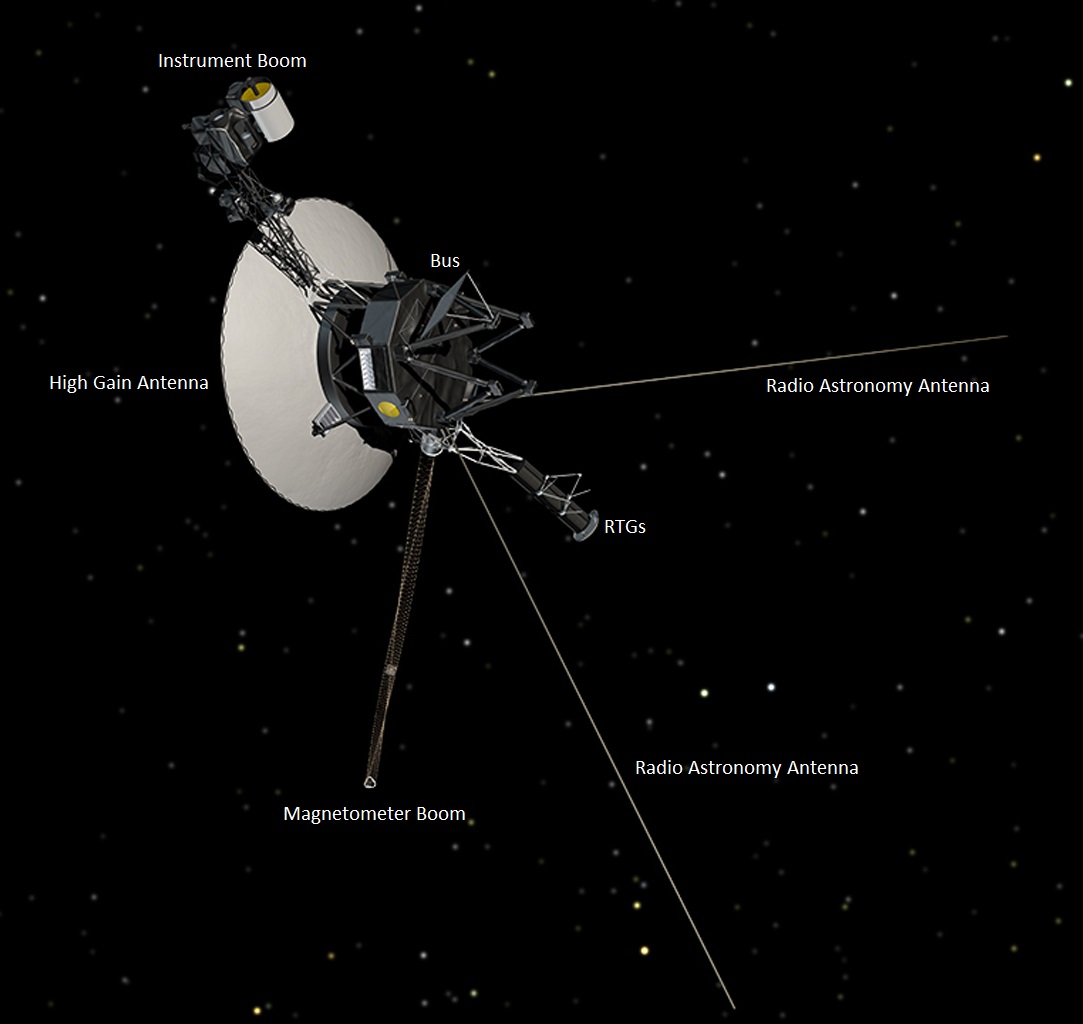 Artist's concept of a Voyager spacecraft in deep space. Labels added.
Credits: NASA/JPL-Caltech
Artist's concept of a Voyager spacecraft in deep space. Labels added.
Credits: NASA/JPL-Caltech
Communication Systems¶
Each spacecraft had a main, central body, called the bus, that housed communication and control systems, including a digital tap recorder for data storage. Attached to the top of the bus is a 3.66 meter diameter parabolic high-gain antenna for communications with Earth.
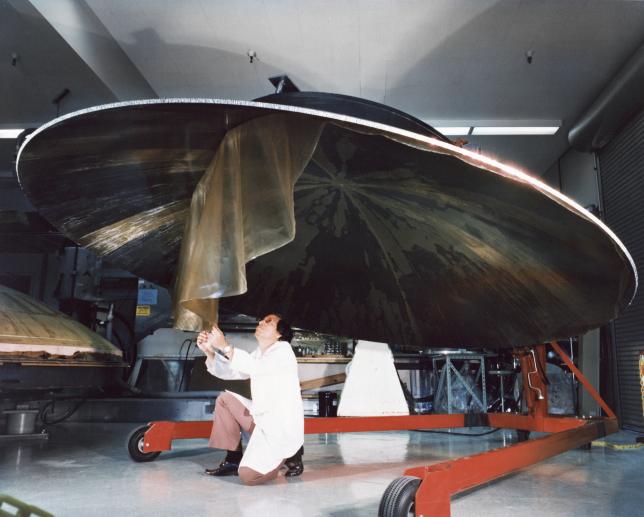 Engineer working on a parabolic Voyager high-gain antenna.
Credits: NASA/JPL-Caltech
Engineer working on a parabolic Voyager high-gain antenna.
Credits: NASA/JPL-Caltech
Orientation and Attitude Control¶
Included behind the parabolic dish are the Sun sensors, which look through a slot in the dish and orientate the spacecraft in the yaw and pitch axis. On the side of the bus are two Canopus trackers, which uses a star, usually the bright southern star Canopus, to orientate in the roll axis. Small rocket thrusters are used to control the probe’s orientation based on the data from these sensors.
During flybys and at other times of the mission, the spacecraft may point else were from the center of the solar system to take pictures or record other science data. It can also be in the shadow of planets, or receive interference from nearby planets, rings and moons. During these times, the internal reference system, utilizing gyroscopes, provides orientation.
Instruments¶
There are also four more major features of the craft, which were folded up for launch. The first is the instrument boom, which holds the majority of the probe’s scientific instruments and cameras. Opposite the instrument boom, extending down, are two antennas that make up the radio astronomy sensors. On the same side, extending up is the magnetometer boom, with the sensitive magnetometer at the end, far away from any magnetic interference from the probe’s electronic systems.
 Low-Energy Charged Particle Instrument Assembly.
Credits: NASA/JPL-Caltech/JHU-APL
Low-Energy Charged Particle Instrument Assembly.
Credits: NASA/JPL-Caltech/JHU-APL
 Engineers working with the deployed magnetometer boom.
Credits: NASA/JPL-Caltech
Engineers working with the deployed magnetometer boom.
Credits: NASA/JPL-Caltech
Power Source¶
Finally, in between the radio astronomy antenna is the spacecraft’s power source. It is made up of an array of three radioisotope thermoelectric generators (RTGs). Each RTG contains samples of Plutonium-238 in the form of plutonium-oxide (PuO2). As the plutonium decays, it creates heat that is then converted into electricity using Seebeck effect, relying on the temperature difference between the plutonium and space.
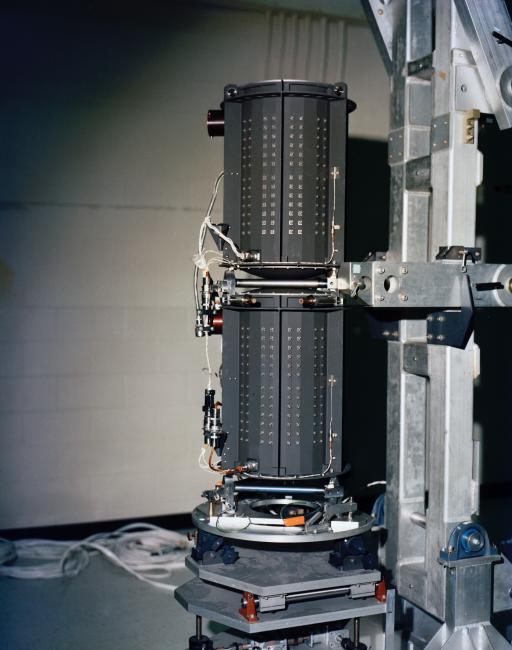 One of the RTGs used by the Voyager probes.
Credits: NASA/JPL-Caltech
One of the RTGs used by the Voyager probes.
Credits: NASA/JPL-Caltech
Launch and Journey¶
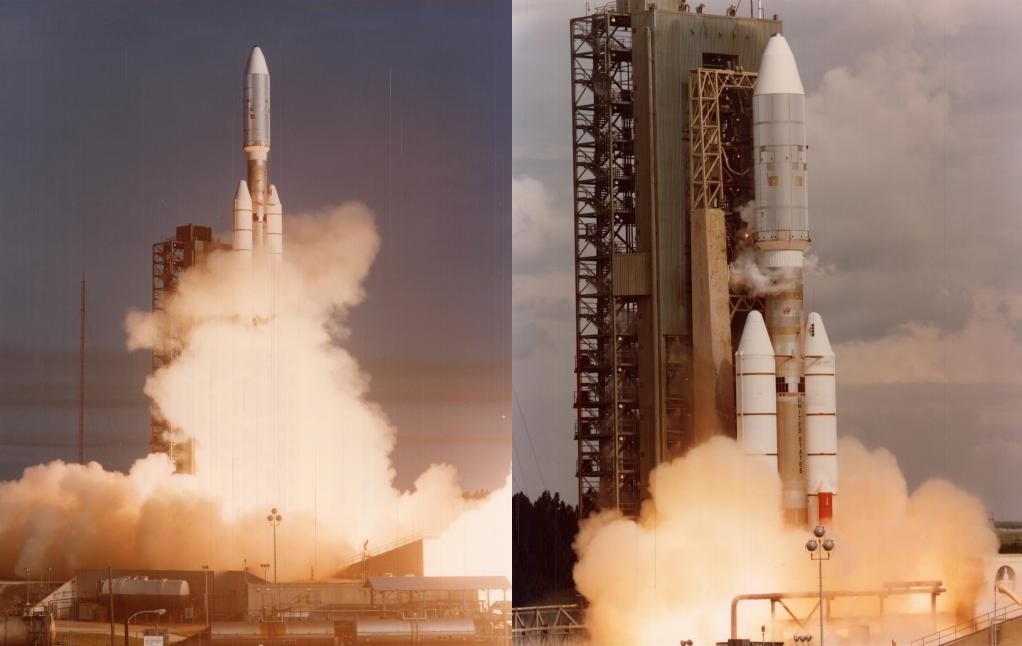 Launch of Voyager 1 and Voyage 2 on their Titan-Centaur vehicles.
Credits: NASA/JPL-Caltech/KSC
Launch of Voyager 1 and Voyage 2 on their Titan-Centaur vehicles.
Credits: NASA/JPL-Caltech/KSC
On August 20, 1977, Voyager 2 was launched on a Titan-Centaur rocket. If the launch and initial stages of the mission were unsuccessful, the Voyager 1 launch could have been adjusted to put it on a trajectory that made visits of Uranus and Neptune possible. Thankfully it was successful and on September 5, 1977 Voyager 1 was launched. Thirteen days later, Voyager 1 pointed its camera back home, capturing both Earth and the Moon in a single frame. While in the asteroid belt, Voyager 1 surpassed Voyager 2 on their way to Jupiter.
 The Earth and Moon, captured in a single frame by Voyager 1.
Credits: NASA/JPL-Caltech
The Earth and Moon, captured in a single frame by Voyager 1.
Credits: NASA/JPL-Caltech
Jupiter¶
Voyager 1 was the first to arrive at Jupiter, arriving on March 5, 1979, almost a year and a half after its launch. Four months later Voyager 2 arrived on July 9 of that same year. During their flybys, three moons were discovered and several other observations lead to surprising discoveries about Jupiter and its moons.
As Voyager 1 approached Jupiter, it took a picture of Jupiter once every Jupiter-day, creating an animation of Jupiter’s chaotic atmosphere.
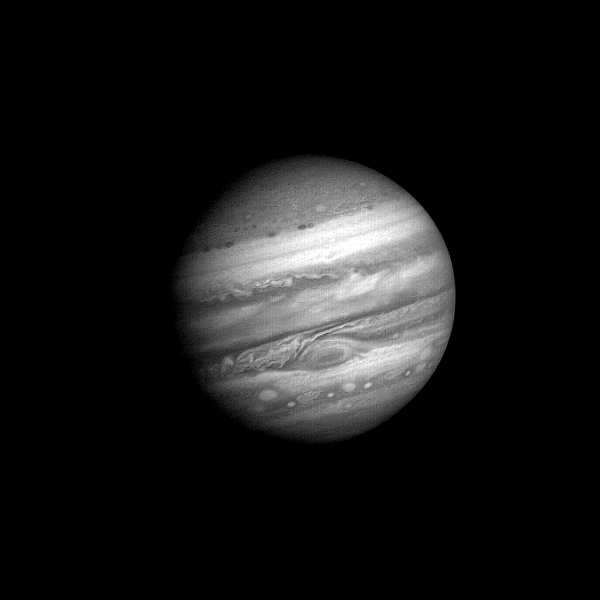 Animation of Voyager 1's approach to Jupiter.
Credits: NASA/JPL-Caltech
Animation of Voyager 1's approach to Jupiter.
Credits: NASA/JPL-Caltech
 Frame from Voyager 1's approach to Jupiter.
Credits: NASA/JPL-Caltech
Frame from Voyager 1's approach to Jupiter.
Credits: NASA/JPL-Caltech
Io¶
Flying by the moon Jupiter, Voyager 1 made the first observation of active volcanic activity other than on Earth. Together Voyager 1 and 2 observed nine separate eruptions with evidence of several others in the four months between the visits of the two. With it being the closest of the Galilean Moons, Io experiences the strongest gravitational pull from Jupiter, the tidal forces from which heats the mantle of the moon, making it one of the most volcanically active bodies in the Solar System.
It was also observed that as Io moves through Jupiter’s powerful magnetic field, Io acts as a giant electricity generator, with 400 kilovolts across its diameter.
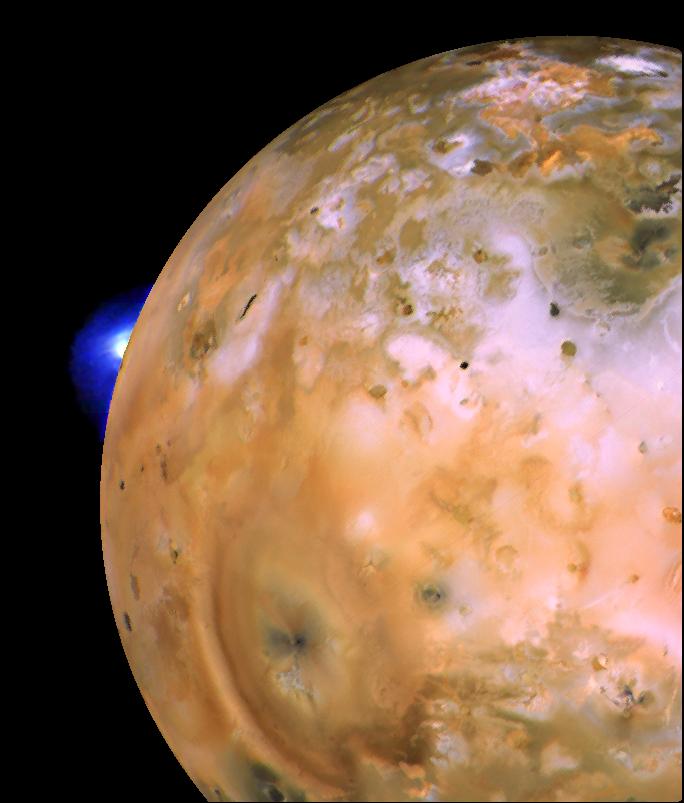 Io with Volcanic Plume by Voyager 1; brightened plume.
Credits: NASA/JPL-Caltech
Io with Volcanic Plume by Voyager 1; brightened plume.
Credits: NASA/JPL-Caltech
Europa¶
Europa was found to have many long rifts, evidence of tectonic activity, but with Voyager 2’s flyby, its surface features were found to be very flat. It is believed that Europa has a thin icy crust on top of an ocean of liquid water.
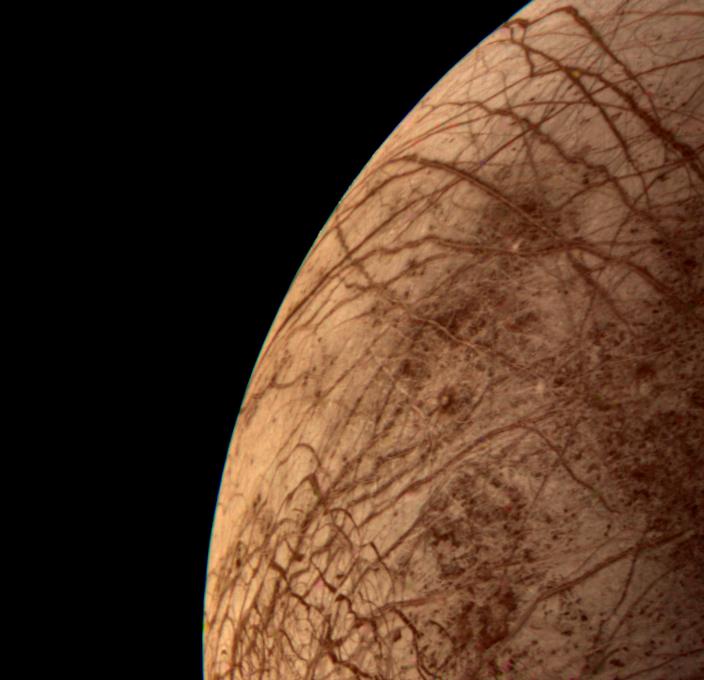 Europa During Voyager 2 Closest Approach.
Credits: NASA/JPL-Caltech
Europa During Voyager 2 Closest Approach.
Credits: NASA/JPL-Caltech
Jupiter’s Rings¶
With their close up views, the Voyager probes also discovered a faint ring system around Jupiter that had never been observed before. The bellow image from Voyager 2 shows the planet’s ring system, blurred by the probe’s motion. You can see the lower of the two orange lines is partially in Jupiter’s shadow.
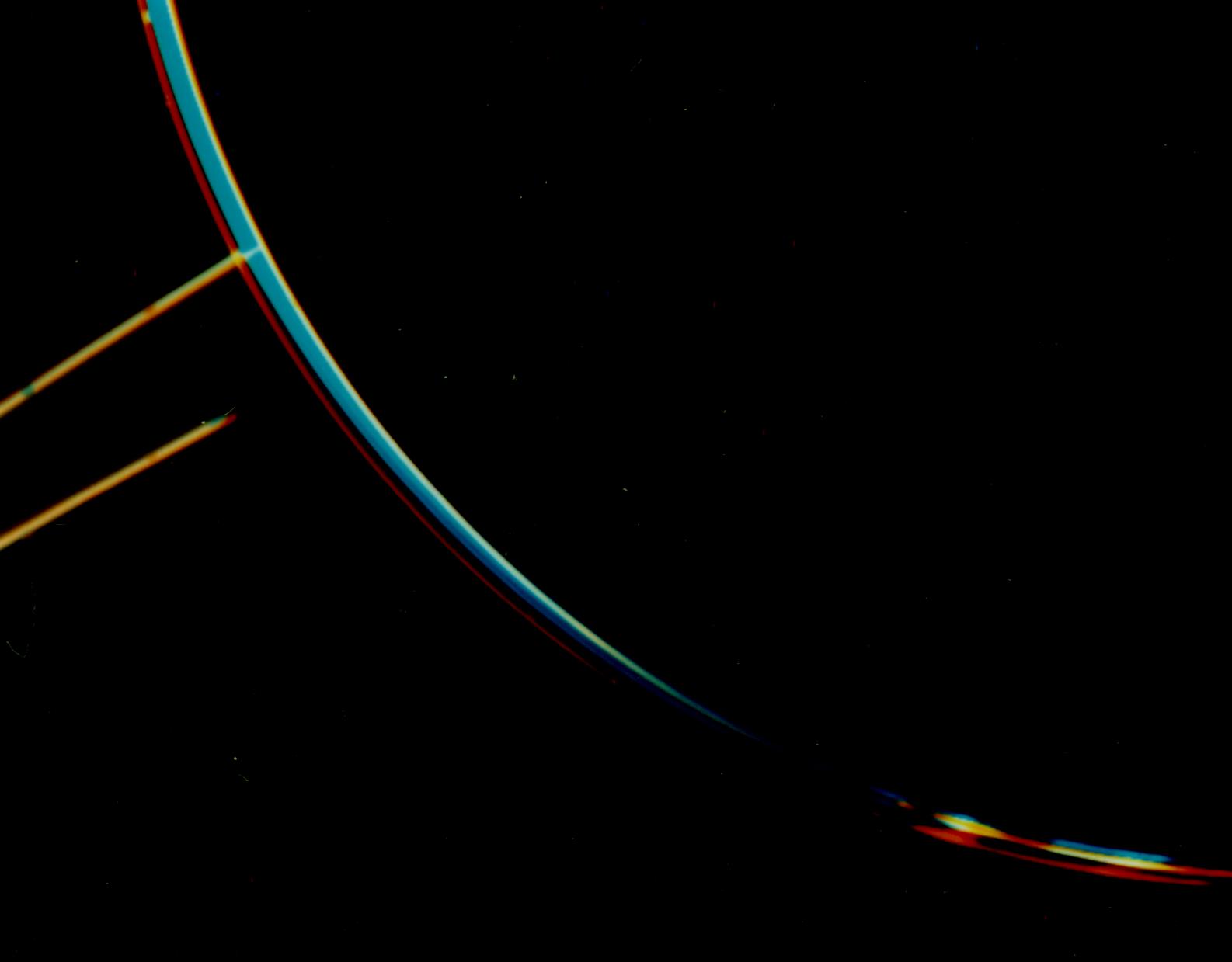 False Color of Jupiter's Faint Ring System by Voyager 2.
Credits: NASA/JPL-Caltech
False Color of Jupiter's Faint Ring System by Voyager 2.
Credits: NASA/JPL-Caltech
Saturn¶
After over another year and a haft of travel, Voyager 1 arrived at Saturn on November 12, 1980, with Voyager 2 arriving more than two years after leaving Jupiter, visiting Saturn on August 25, 1981.
Shortly before the visit of the Voyager probes, Pioneer 11 completed its six and a half year journey to Saturn, laying the groundwork for the Voyager probes, especially Voyager 2’s gravity assist to take it on to Uranus and Neptune.
One fascinating discovery was of Saturn’s active atmosphere. When in visible color and observed from Earth, Saturn’s atmosphere appears very plain, but with a closer look, and with ultraviolet imaging, bands of clouds with storms were found.
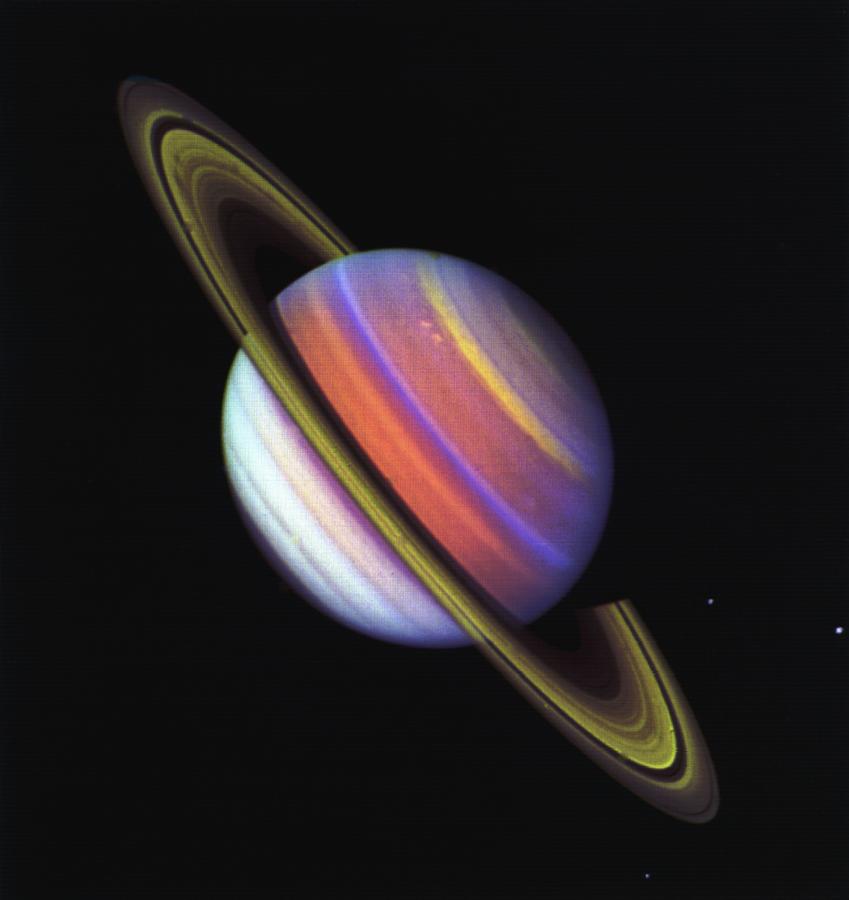 Approach of Voyager 2 to Saturn in false color.
Credits: NASA/JPL-Caltech
Approach of Voyager 2 to Saturn in false color.
Credits: NASA/JPL-Caltech
Titan¶
 False color of Titan's atmospheric haze by Voyager 1.
Credits: NASA/JPL-Caltech
False color of Titan's atmospheric haze by Voyager 1.
Credits: NASA/JPL-Caltech
With scientist’s interest in Titan and its atmosphere, Voyager 1’s trajectory was optimized for a flyby, the closest flyby of any body during the Voyager Missions. Information about the atmosphere’s density and composition were made, but no observations of the surface could be done because of the thick clouds. This led to further questions about the moon and a probe landing in 2005.
This flyby put Voyager 1 on a course above the ecliptic of the Solar System, flying out of the Solar System. As a trade off for the Titan flyby, a flyby of Pluto was now no longer possible. With the resilience of the probes and excellent operational conditions, their missions were extended, with Voyager 2 moving on to Uranus and Neptune.
 Saturn and its rings as Voyager 1 leaves.
Credits: NASA/JPL-Caltech
Saturn and its rings as Voyager 1 leaves.
Credits: NASA/JPL-Caltech
Uranus¶
As its hyperbolic trajectory brought Voyager 2 further from the Sun, its speed decreased, and the distance between planets increased, so Voyager 2’s journey between the planets grew longer. With it being four year after Saturn, it finally arrived, this time alone, at Uranus on January 24, 1986.
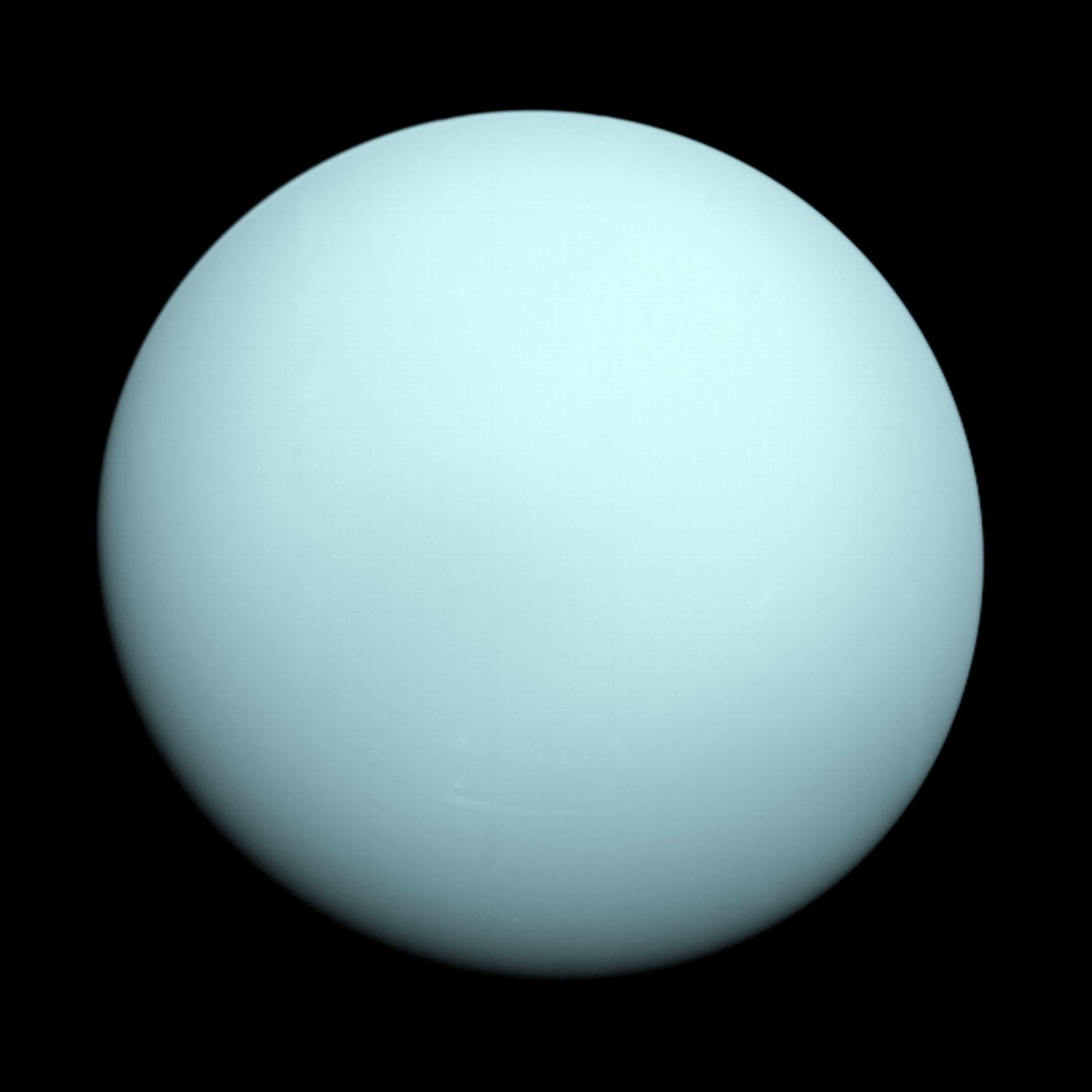 Voyager 2 approaches Uranus.
Credits: NASA/JPL-Caltech
Voyager 2 approaches Uranus.
Credits: NASA/JPL-Caltech
Icy Moons¶
During its flyby, Voyager 2 visited several known moons and discovered 10 previously unknown moons. It also took the first quality pictures of Uranus as previously ground based telescopes could only get a small, mostly uniformly colored circle.
The ice-rock conglomerate moon, Miranda was found to be particularly interesting as its surface was a mix of old and new, with large features and canyons ten times deeper than the Grand Canyon on Earth. A major idea is that it underwent a violent impact.
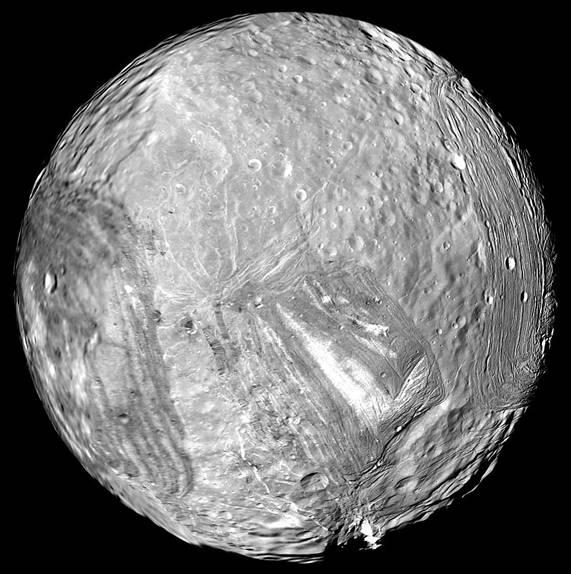 The icy moon Miranda by Voyager 2.
Credits: NASA/JPL-Caltech
The icy moon Miranda by Voyager 2.
Credits: NASA/JPL-Caltech
Young Ring System¶
Also interesting was that the previously known ring system was found to be very different from Jupiter and Saturns’ rings and are relatively young. They were likely the results of major impact or tidal forces ripping a moon apart.
The moon Ariel was found to have a young surface showing evidence of recent geological activity. With the distance from the Sun and cold temperatures, flows of not volcanic rock, but rather icy material were found on its fractured surface.
 The icy moon Ariel by Voyager 2.
Credits: NASA/JPL-Caltech
The icy moon Ariel by Voyager 2.
Credits: NASA/JPL-Caltech
Magnetic Field¶
Probably most anticipated was the question of if Uranus had a magnetic field and what its characteristics were. They were surprised to find a very odd magnetic field, its center being offset from the center and tilted 60 degrees from the planet’s already sideways axis of rotation. This lead to its magnetotail being twisted behind it.
Neptune¶
After another four years of travel and twelve years after launch, Voyager 2 reached Neptune on August 25, 1989. Again scientist were in for quite the surprise. Even after the launch of the Hubble Space Telescope, Voyager 2’s pictures remain the best yet of the planet, but Hubble did provide excellent follow up data from some of the discoveries made.
 Voyager 2's approach of Neptune.
Credits: NASA/JPL-Caltech
Voyager 2's approach of Neptune.
Credits: NASA/JPL-Caltech
The Great Dark Spot¶
One of the largest discoveries of the planet made was the presence of a large dark storm, similar to The Great Red Spot, and was appropriately dubbed The Great Dark Spot. About the size of the Earth, speeds were measured to be up to 1,200 miles per hour (2,000 km/h), the fastest observed in our Solar System. Hubble has since shown that this storm has disappeared.
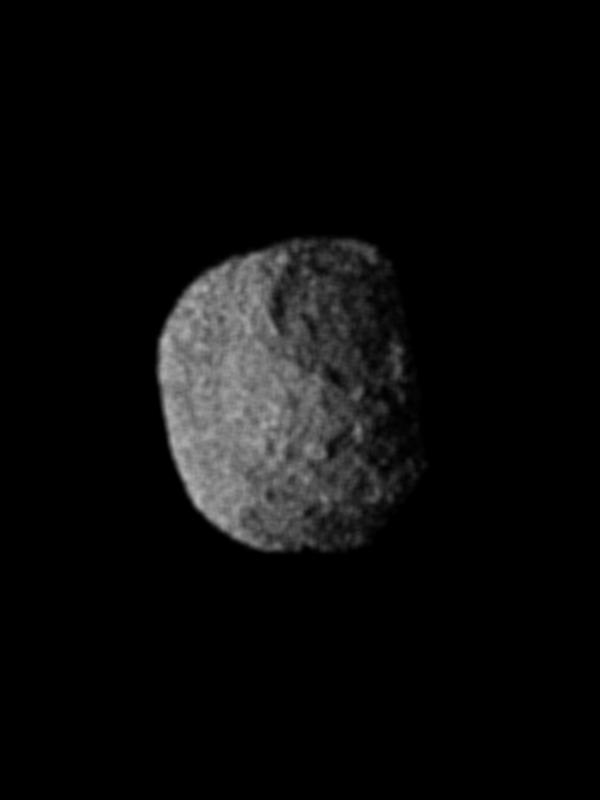 Proteus (1989N1): a moon discovered by Voyager 2.
Credits: NASA/JPL-Caltech
Proteus (1989N1): a moon discovered by Voyager 2.
Credits: NASA/JPL-Caltech
Triton¶
Of particular interest to scientists was Neptune’s largest moon, Triton. With no further targets after Neptune engineers optimized Voyager 2’s flyby trajectory to accommodate Triton’s odd orbit with its high inclination. Also odd was that they discovered that Triton had a relatively high density. That with its retrograde orbit, it is believed that it is a captured satellite, not originally from the Neptune system. Also they found geysers of nitrogen, contributing to a thin atmosphere, with occasional clouds of nitrogen ice.
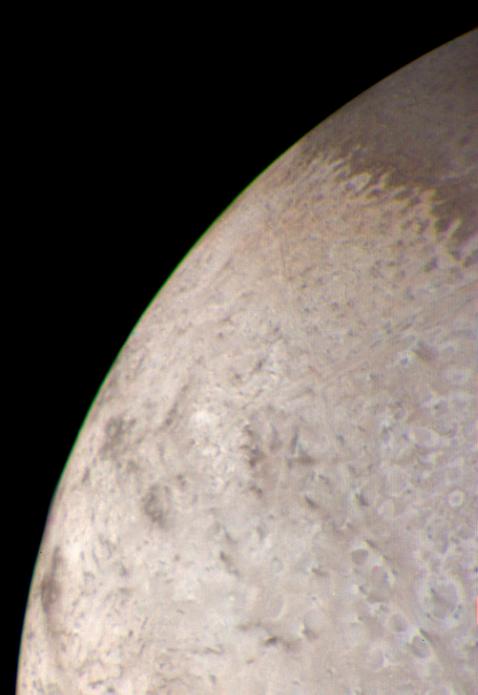 Voyager 2's image of Uranus' largest moon, Triton.
Credits: NASA/JPL-Caltech
Voyager 2's image of Uranus' largest moon, Triton.
Credits: NASA/JPL-Caltech
Magnetic Field and Rings¶
Especially after the surprise of Uranus’ magnetic field, scientist were anxious to learn about Neptune’s magnetic field, and they were not disappointed. While not as extreme as Uranus’, they found its magnetic field was off center and was tilted from its axis of rotation. Also with its close up view, it was shown that Neptune had complete rings, which previously was uncertain as the rings were difficult to resolve.
 Image of Neptune and its outermost rings by Voyager 2.
Credits: NASA/JPL-Caltech
Image of Neptune and its outermost rings by Voyager 2.
Credits: NASA/JPL-Caltech
Interstellar Mission¶
To this day the Voyager spacecraft continue to sent back valuable scientific data as they have continued out of the solar system. As time has gone on, some of the Plutonium in the RTGs has decayed, reducing their power output. To have enough energy to continue operations, instruments and other supporting systems have been shutdown.
A Family Portrait¶
Before shutting down the cameras on Voyager 1, scientists and engineers decided to take one more set of images. The subject: our Solar System. On February 14, 1990 A mosaic of 60 images was taken capturing Venus, Earth, Jupiter, Saturn, Uranus, and Neptune. Pluto was too small and dim, Mars was not visible because of sunlight scattering inside the optics, and Mercury is too close to the Sun.
 Solar System Family Portrait by Voyager 1 in 1990.
Credits: NASA/JPL-Caltech
Solar System Family Portrait by Voyager 1 in 1990.
Credits: NASA/JPL-Caltech
With the 60 wide angle frames, narrow angle images were taken of these planets as well, including the famous Pale Blue Dot. These pictures are the furthest pictures ever taken of our Sun and Planet.
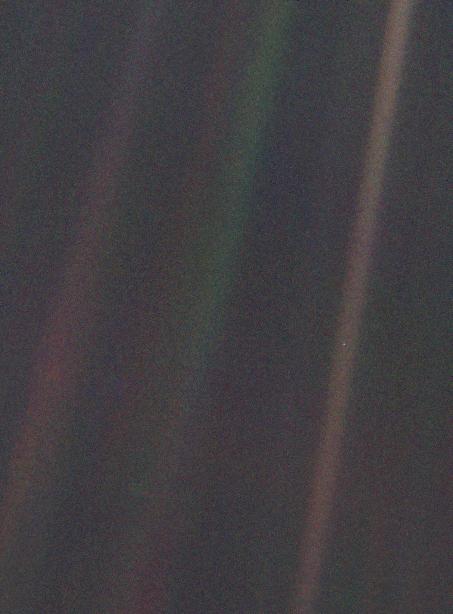 Earth, the "Pale Blue Dot", from the Solar System Family Portrait.
Credits: NASA/JPL-Caltech
Earth, the "Pale Blue Dot", from the Solar System Family Portrait.
Credits: NASA/JPL-Caltech
The edge of the Solar Wind¶
The next milestone for the Voyager spacecrafts was to pass the termination shock, or where because of interaction with the interstellar medium, the speed of the solar wind slows down to subsonic speeds relative to the sun. After about nine more years of travel, both probes eventually crossed the heliopause and entered the interstellar medium, and exiting the Sun’s protective magnetosphere. The probes still continue to send data from the cosmic ray system, low-energy charged particle instrument, plasma sensors, magnetometers, and radio astronomy antennas.
Later Exploration¶
Still fascinated by the outer planets and still having questions, more missions were sent by NASA to study the outer Solar System. The Galileo and Juno orbiters were sent to Jupiter, Cassini with its Huygens lander probe visited Saturn and Titan, with New Horizons becoming the first to visit Pluto and Charon.
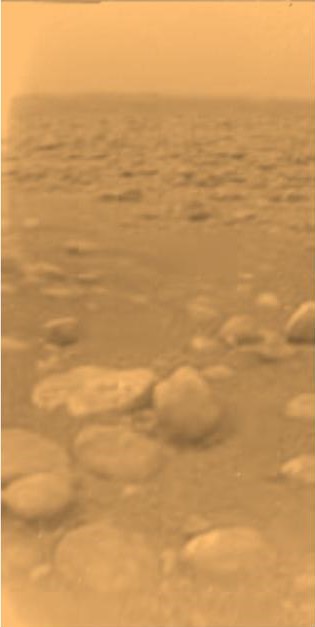 Titan's Surface after the landing of the Huygens probe.
Credits: NASA/JPL/ESA/University of Arizona
Titan's Surface after the landing of the Huygens probe.
Credits: NASA/JPL/ESA/University of Arizona
Future of the Voyager Mission¶
Engineers hope to continue the mission for as long as the spacecraft continue to send data. Current plans power management strategies will keep the probes operational for a few more years. As they continue on, silent, they will pass by other stars in the galaxy, and possibly be discovered by intelligent life, on which they will find a golden record, containing a message in a bottle. Message from the human race saying “Hi, this is who we are.”
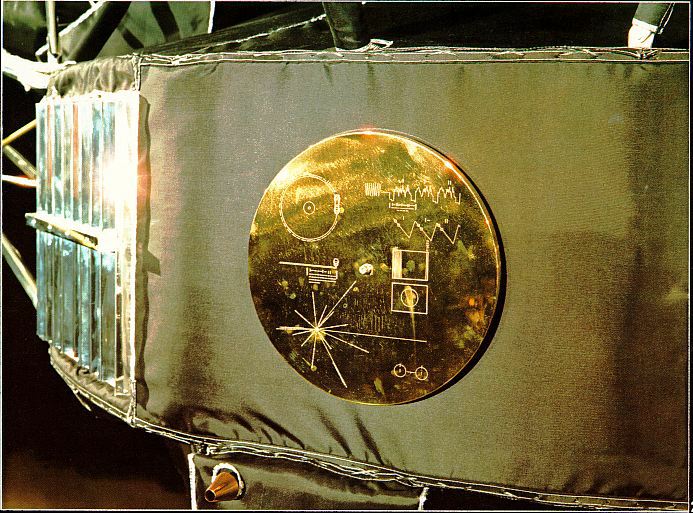 The Golden Record Cover installed on one of the Voyager probes.
Credits: NASA/JPL-Caltech
The Golden Record Cover installed on one of the Voyager probes.
Credits: NASA/JPL-Caltech
Appendix¶
Sources¶
NASA Space Science Data Coordinated Archive
NASA Technical Reports Server
NASA Science
PHYS 1060 Project Links¶
Website may not be online at night.